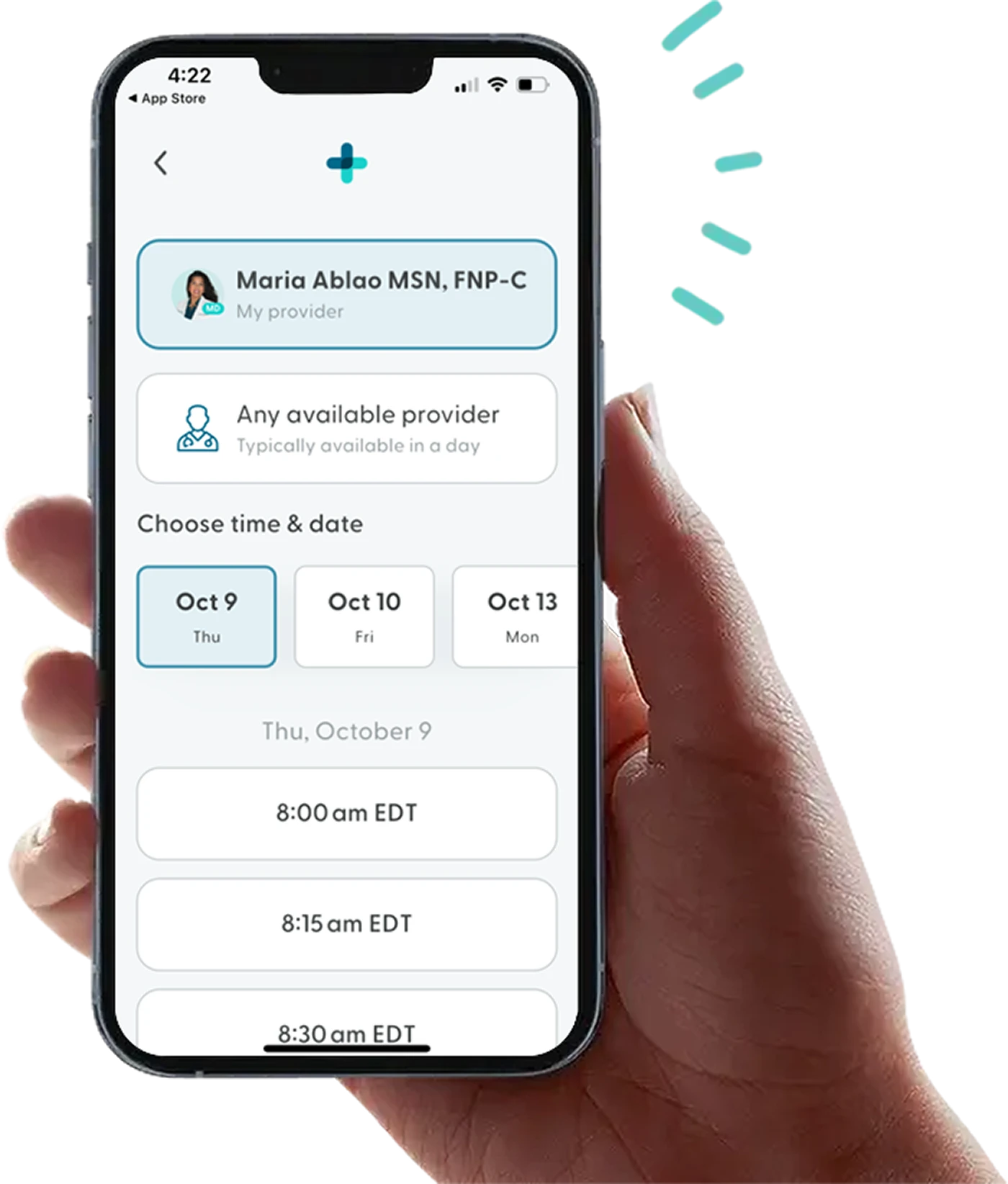When is the Best Time to Start Hormone Replacement Therapy?
Hormone replacement therapy (or HRT) is often used to help ease the frustrating symptoms that can come with menopause and the years leading up to it. During perimenopause, shifting hormone levels can trigger hot flashes, night sweats, mood changes, sleep disruptions, and more. For some women, HRT for perimenopause or targeted progesterone replacement in perimenopause can bring meaningful relief and improve quality of life.
But when you start HRT matters. Beginning too early may not be necessary, while waiting too long could affect how well it works and may change the balance of benefits and risks. In this article, we’ll look at whether perimenopause is the right time to consider HRT, how to figure out the right timing for you personally, and what it means if you’ve waited until later to start.
Feel like yourself again
A licensed provider can help you understand your symptoms and determine if hormone replacement therapy is the right next step.


Understanding Perimenopause and HRT
Perimenopause is the transitional phase leading up to menopause, when your ovaries gradually produce less estrogen and progesterone. This hormonal shift doesn’t happen all at once – it can span several years and bring a mix of physical and emotional changes. You may notice symptoms like hot flashes, night sweats, irregular or heavier periods, mood swings, and trouble sleeping. These changes are a natural part of aging, but for some, they can be disruptive enough to affect daily life.
For women looking for relief, hormone treatment for perimenopause can be an option. Hormone replacement therapy works by supplementing the body’s declining hormones, often focusing on estrogen replacement during perimenopause to help ease symptoms.
Depending on your individual needs, hormone replacement therapy (HRT) may be prescribed as estrogen-only therapy for women who have had a hysterectomy or as a combination of estrogen and progesterone. Health experts typically prefer bioidentical micronized progesterone over synthetic progestins, which carry a higher risk profile. In most cases, it’s recommended to use progesterone alongside estradiol – even for women without a uterus – to help maintain hormonal balance and overall safety.
Estrogen can be delivered in different ways – including pills, patches worn on the skin, gels, sprays, and vaginal creams or rings – giving you and your provider options to tailor treatment to your lifestyle and health profile.
Perimenopause often spans anywhere from two to ten years and is marked by shifting hormone patterns. During this time, ovulation becomes irregular, leading to a drop in progesterone while estrogen levels rise and fall unpredictably. These fluctuations can leave women feeling wired yet exhausted, disrupt sleep, and cause heavy or irregular bleeding – not necessarily because estrogen is low, but because hormones are out of balance.
Menopause, defined as twelve consecutive months without a period, brings a more stable phase of hormonal change characterized by consistently low estrogen and little to no natural progesterone production. This is when bone loss tends to accelerate, hot flashes often peak, and vaginal or urinary symptoms become more noticeable.
Systemic hormone therapy is generally most effective when started around the time of menopause, typically within ten years of the final menstrual period. The benefits can include improved sexual function, better heart and metabolic health, healthier skin and muscle tone, urogenital comfort, and stronger bones.
When to Start HRT for Perimenopause
Deciding when to start HRT for perimenopause isn’t the same for everyone. Your symptoms, age, and overall health history all play a role in the timing. If symptoms are starting to interfere with daily life, and you don’t have medical conditions that would make hormone therapy unsafe, it may be worth discussing your options with a healthcare provider.
Medical providers often talk about a “window of opportunity” for HRT – starting before age 60 or within 10 years of your final menstrual period is generally linked to the greatest benefits and fewer risks. For women in perimenopause, this means you may not have to wait until your periods stop to begin treatment. In fact, when you start HRT can depend on how early symptoms show up and how much they affect your quality of life.
Your provider will look at the severity of your symptoms, your age and how close you are to menopause, your personal and family history of conditions like heart disease, breast cancer, or blood clots, and whether you have concerns about bone loss.
In many cases, starting during perimenopause can help manage symptoms effectively and may even offer bone and heart health benefits over time. When you can start HRT will ultimately come down to a conversation with your doctor, who can help balance your symptom relief goals with your personal risk factors.
When it May Be Too Late to Start HRT
In most cases, doctors do not recommend beginning hormone therapy more than 10 years after menopause or after age 60. By this stage, the potential risks – particularly to heart and vascular health – are generally considered to outweigh the benefits for women who have not previously been on HRT.
In this sense, “too late” refers to a point where starting therapy is no longer advised for safety reasons, rather than just a shift in the balance of risks and benefits. If you’re approaching menopause or recently past it, it’s best to talk with your healthcare provider early to explore whether HRT is right for you and to make the most of the time when it can be both safe and effective.
Typically, the best time to start systemic HRT is within the first zero to 10 years after menopause. After 10+ years past menopause, initiation should involve a careful discussion with your HRT provider and a proper risk-stratification work-up. It’s possible to safely start HRT if you are over 10 years out from menopause, but it involves careful decision making with the patient and provider.
“Too late” is rarely absolute, but the benefit–risk balance shifts as you move further from your final menstrual period.
Where Can I Learn More About Hormone Balance?
If you're experiencing symptoms associated with hormonal imbalance, you don’t have to tough it out alone. With personalized hormone therapy, expert guidance, and support that fits your life, getting back to balance is more accessible than ever – thanks to LifeMD.
Make an appointment today and take the first step toward feeling like you again.
More articles like this
Feel better with LifeMD.
Your doctor is online and ready to see you.
Join LifeMD for seamless, personalized care — combining expert medical guidance, convenient prescriptions, and 24/7 virtual access to urgent and primary care.

HRT Support
Talk with a provider about whether hormone replacement therapy is right for you.
Get Started Now
 Medically reviewed and edited by
Medically reviewed and edited by 






